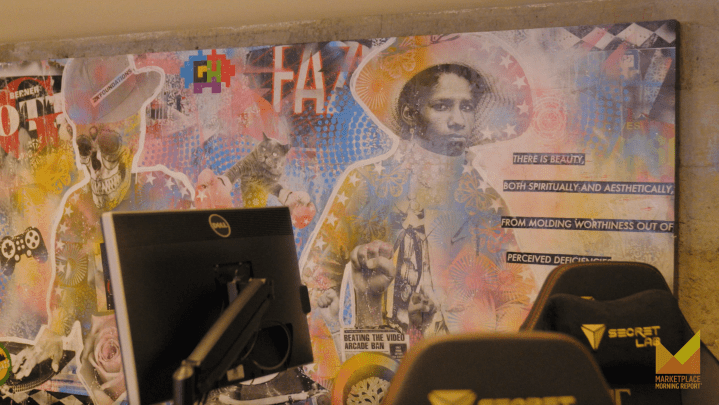
Sideshow culture gets the video game treatment
Sideshow culture gets the video game treatment

Video games are a bigger money maker than movies and music combined. What can the games — and the vast industry that surrounds them — tell us about economics, business, money, careers and equity? We’re doing a project on “Marketplace Morning Report” called “Skin in the Game“. Here, on the radio and in streamable video, it’s a full-immersion virtual adventure meeting people working to crack into the industry itself.
The rear ends of cars drift with the front tires locked hard-right or left. You can almost smell the rubber burning as the crowd cheers and dances. It’s a video game that draws from what’s called sideshow culture — drivers showing off moves, a tradition with roots in Oakland, California.
Trevor Cardoza was part of a student team that created a video game drawing from these sideshows, as part of Gameheads, a mentoring program in Oakland that teaches game development to high school kids and young adults.
They call their game “HighSidin’”, but in this virtual version, the cars doing donuts are not drifting in crosswalks designed for pedestrians. The game action plays out in a ring with barriers to keep the virtual crowd safe.

In real life, these daredevil displays have killed people and politicians have tried to crack down on them. The student game developers wondered what it might be like if these car stunts were safer and formalized into a sport.
“What if they were not shown in such a bad light?” said Cardoza. “They were originally meant to be car shows, essentially, and just hyphy movements. But now it seems like it’s a response to gentrification and the change of culture.”
Hyphy is a word out of Oakland meaning energetic, hyped up. It’s a music style and a dance style, so the Gameheads students came up with the car game and a separate dance game.
“I worked on interpreting the mechanics behind the things that they were creating, and trying to find ways that their passion for a culture can be communicated visually,” said Anaya Crouch, one of the developers who worked on “HighSidin'”.
Crouch is from Southern California and didn’t grow up in contact with sideshow cars or hyphy dances. So she did her field work.
“Doing research and then taking apart things and putting things back together in a way that is more genuine to their experience,” she said
There’s a creative tension here. On one hand, the team thought about what the rulebook of these activities would be if it became a formal sport that offered prizes and attracted sponsors.
On the other…
“We didn’t want to put weird generalizations and weird like strict rules on it,” said Cardoza. “Because in the sense sideshows are meant to be freestyle, that’s the whole point of hyphy movement.”

Editions of “HighSidin’” and “HighSidin’: Hyphy Edition” are available for PCs. The dance version is available on mobile. Google heard about these games and granted the developers $65,000 to be shared with this group and students who did another title, “Camino”, that explored the Cuban slave trade.
The founder of Gameheads, Damon Packwood, was blown away by how the students used a lot of the money.
“So what they did is they went out into the Black community and found talent,” said Packwood. “They found sound designers, they found people that can do music, they found videographers. And so they were actually investing money back into the Black community. I was amazed when I saw it. I didn’t tell them to do this.”
Cardoza went on from Gameheads, graduated from college and got a job gamifying advanced medical devices. But this spring, a plot twist. With Silicon Valley startups shaken by the skidding stock market and bank failures, Cardoza got laid off. It’s a pattern Gameheads mentors have experienced themselves.
“We talk about that ebb and flow,” said Paul Rybicki, a game design pro who adds resilience to his teaching. “Okay, that project fell apart. How do you pick yourself up, dust yourself off and continue when that’s really, really hard?”
Cardoza is now buffing up his resume as he looks for something else. Fellow Gameheads alum Anaya Crouch is focused on animation and with her UC Berkeley degree now in hand, she’s lining up graduate study.
All these tech jobs, but young people growing up in Silicon Valley don’t feel welcome in the industry. We’ll dive into how Gameheads addresses that with a curriculum that welcomes anything cool. Explore how they do it by checking out our Skin in the Game web series, just a click away on Youtube.
And tell us your own story about learning about money, business and economic from video games, email morningreport@marketplace.org.
There’s a lot happening in the world. Through it all, Marketplace is here for you.
You rely on Marketplace to break down the world’s events and tell you how it affects you in a fact-based, approachable way. We rely on your financial support to keep making that possible.
Your donation today powers the independent journalism that you rely on. For just $5/month, you can help sustain Marketplace so we can keep reporting on the things that matter to you.












